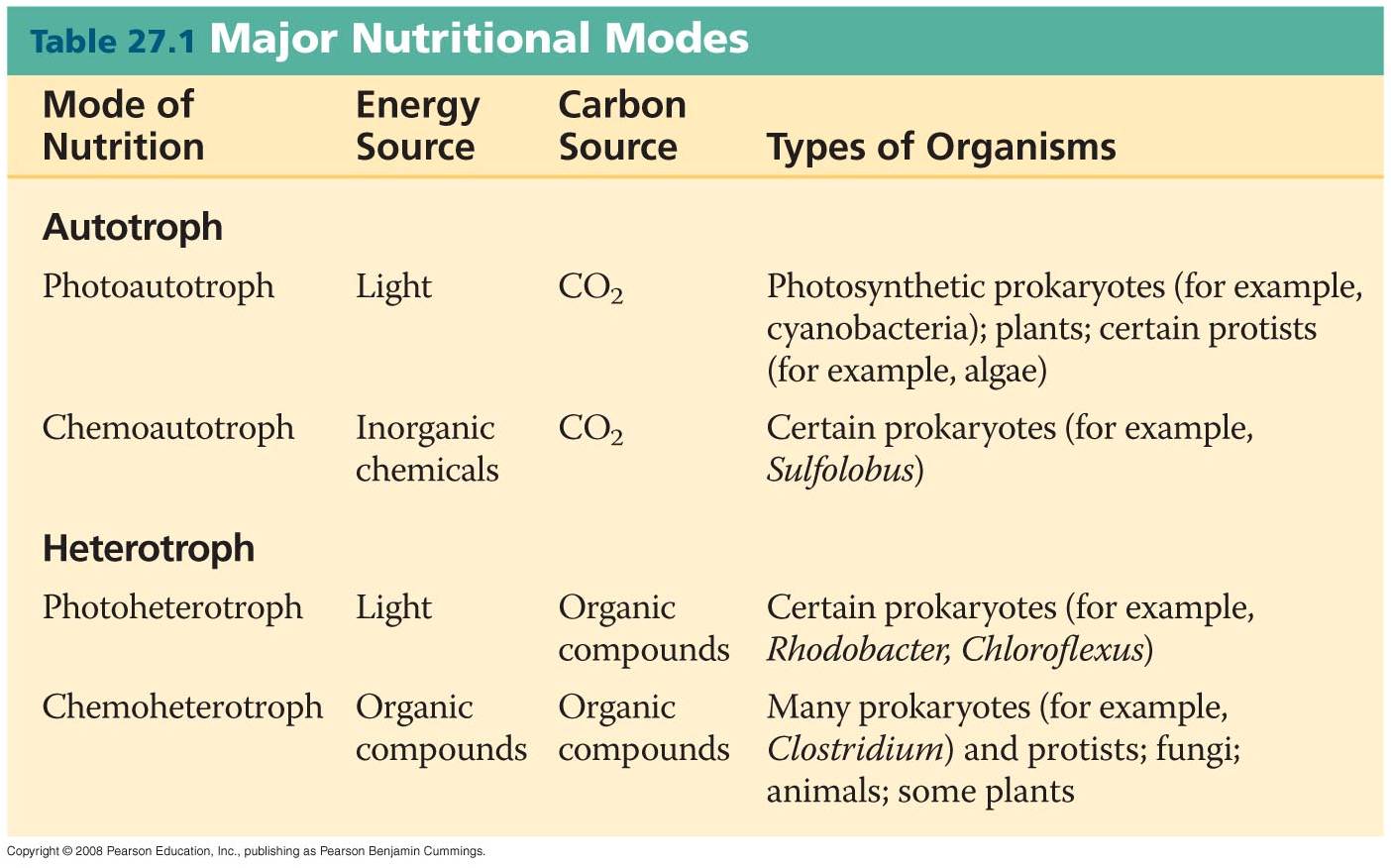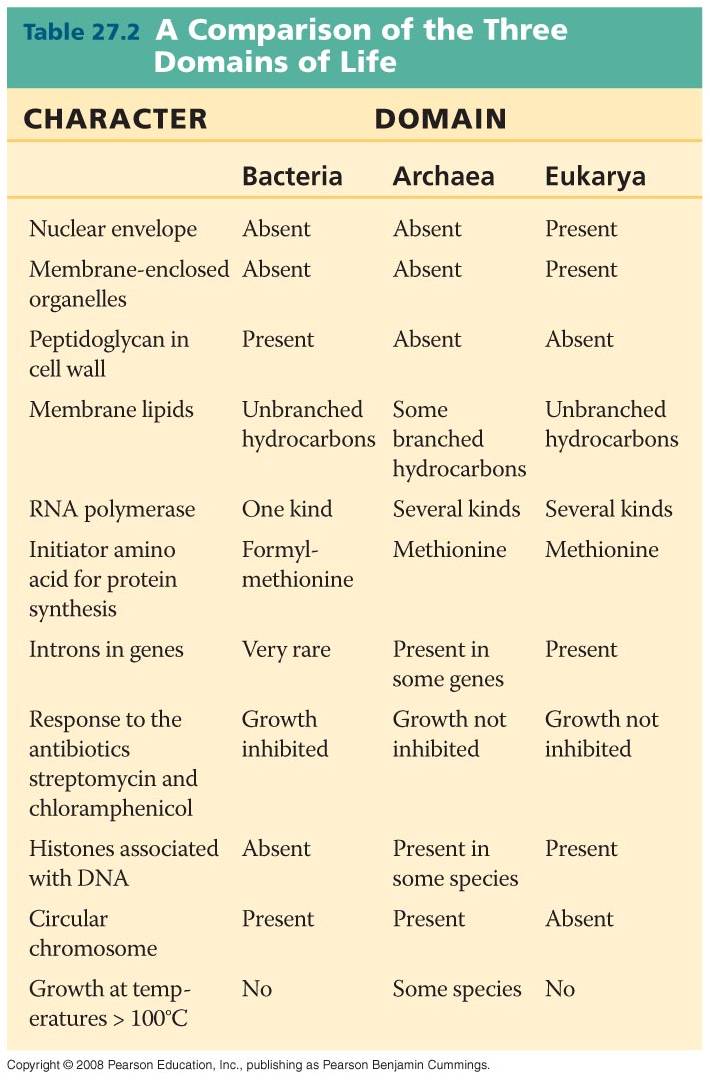|
What were the first organisms to inhabit Earth? |
|
Prokaryotes |
| |
|
What are teh three most common shapes of Prokaryotes? |
|
Spherical (Cocci)
Rod-shaped (Bacilli)
Spiral
|
| |
|
What does the cell wall do in Prokaryotes? |
|
Maintains cell shape
Provides physical protection
Prevents bursting in hypotonic environment
Prevents shrinking in hypertonic environment
|
| |
|
If the Prokaryote loses water, what will happen internally? |
|
Severe water loss inhibits cell reproduction |
| |
|
Eukaryotic cell walls are made of cellulose or chitin, while Prokaryotic cell walls are made from...(name and define) |
|
Peptidoglycan - a network of modified-sugar polymers cross-linked by short polypeptides |
| |
|
Does the Prokaryote have any of these: nuclear envelope, memebrane-bound organelles, introns, circular chromosomes? |
|
No to all except circular chromosomes |
| |
|
Do Archaea have peptidoglycan? |
|
No, but they have a lot of other polysaccharides and proteins, NO PEPTIDOGLYCAN |
| |
|
How do we distinguish between different types of (Eu)bacteria? (just the name) |
|
We use the Gram Stain method, divides bacteria into two groups based on cell-wall composition |
| |
|
What is Gram-Positive and Gram-Negative Bacteria? |
|
G-P: simpler walls, large amounts of peptidoglycan on top with cell membrane on bottom and proteins mixed in
G-N: more complex, less peptido-glycan, but they have not only a plasma membrane on bottom but a new outer membrane on top that is technically considered part of the cell wall with the peptidoglycan that's in the middle. Their outermembrane contains a lot of lipopolysaccharides (carbs bonded to lipids)
|
| |
|
How does the Gram-Stain Method Work? |
|
Samples are stained with a crystal violet dye, iodine, alcohol, and then another red dye. GP bacteria will trap the crystal violet which will mask the red dye. The GN bacteria will not capture crystal violet dye easily, and will absorb the red dye.
GP purple
GN red
|
| |
|
How is Gram-Staining important (like in medicine) |
|
The lipid portions of the lipopolysaccharides of GN bacteria are really toxic, causes fever or shock, and the GN outer membrane will protect from body defenses, its more resistant. When you detect it, you will know how to treat it better. |
| |
|
What is the outer most layer of a prokaryote? Cell Wall? (name and define) |
|
The capsule - a sticky later of polysaccharide or protein, enables prokaryote to adhere to their substrate or other individuals or colony, protect against dehydration, protect prok from attacks |
| |
|
How exactly do Prokaryotes stick to their substrate or to whatever? (name and define) |
|
Fimbriae - hair-like protein appendages |
| |
|
What are sex pili? |
|
Appendages that pull two cells together priod to DNA transfer from one cell to another |
| |
|
How fast can prokaryotes move? |
|
50 um/sec, 50 times their body length |
| |
|
What is a flagella? |
|
A filament made of flagellin that is connected to a hook and ten a basal apparatus (with a motor) and fused into the plasma membrane
It helps the prokaryotes move, randomly or toward a direction
|
| |
|
How are prok flagella different from euk flagella? |
|
1. Prok flagella are 1/10 the width of euk flagella
2. Prok flagella are not covered by an extension of the plasma memb
3. Prok flagella rotate and don't ungulate in a whip like motion
|
| |
|
Explain taxis and how it relates to motility |
|
In a heterogeneous environment, prokaryotes exhibit taxis, movement towards a stimulus
Chemotaxis (response to chemicals; positive - toward food; negative - away from toxic substance)
|
| |
|
Some prokaryotic cells do have specialized membranes that perform metabolic functions? What membranes |
|
The infoldings of the plasma membrane - reminiscent of cristae of mitochondria, function in cellular resp in some aerobic prok; photosynthetic cyanobacteria have thylakoid membranes, like chloroplasts |
| |
|
Where are the chromosomes located in the prokaryote? |
|
In a region called the nucleoid |
| |
|
How are the chromosomes arranged? |
|
Prokaryotes usually have ONE single chromosome, just folded, and a couple of small plasmids (replicating DNA that carry only a few genes) |
| |
|
Describe binary fission. |
|
It is quick, in a favorable env.
A single prok cell divides into 2
Prok can divide every 1-3 hours/ New generation in 20 min!
|
| |
|
So why don't they take over the world in numbers... |
|
Their reproduction is limited, cell eventually exhausts the nutrient supply, poison themselves with metabolic wasts, or face competition with other microorganisms, or eaten by others |
| |
|
How do some prokaryotes withstand harsh conditions (hint: resistant cells) |
|
Certain bacteria develop endospores - resistant cells
When an essential nutrient is lacking, the original cell makes a copy of its chromosome and surrounds it with a wall, forming an endospore, water is removed from the endospore, so the metabolism stops
If the rest of the cell disintegrates, and leaves he endospore behind (endospores are very durable, survive in killer temperatures and pressures), when the env reaches normal, it can rehydrate and resume metabolism
|
| |
|
How are prokaryotes so different if they reproduce by binary fission? |
|
Insertions, deletions, base-pair substitutions, other spontaneous mutations, and a LOT of rapid reproduction
New mutations are rare but can greatly increase genetic diversity in species with short generation times and large pop sizes, means rapid evolution
|
| |
|
What is transformation? |
|
The genotype and possibly phenotype of a prokaryotic cell are altered by the uptake of foreign DNA from its surroundings
Live nonpathogenic cells take up pieces of DNA carrying the allele for pathogenicity,
|
| |
|
What is transduction? |
|
First a bacteriophage infects a bacterial cell, the host DNA of the bacteria is fragmented (defense mechanism), more phage DNA is made and one phage may have uptook the original bacteria DNA. So then the cell bursts and the phages go and infect other cells. That certain phage with the bacteria DNA can infect another recipient cell and replace the homologous region of the recipient cell's chrom.
|
| |
|
What is conjugation? |
|
When genetic material is transferred between two bacterial cells, temporarily joined, through the sex pillus, DNA transfer is one way, one cell donates DNA and other receives, sex pillus of one attaches to the other,
First the cells attach then the pilus retracts, pulling them closer together, then form mating bridge,
|
| |
|
What is the F factor? |
|
In most cases, the ability to form the sex pili and donate DNA during conjug results from whether you have the F factor (fertility) - its a piece of DNA (25 genes) required for production of sex pilus, it can be a plasmid or a segment of the chromosome |
| |
|
What does F+ F- Hfr mean? |
|
If you have the F plasmid (considering its in a plasmid), that cell is designated F+, functions as DNA donors during conjug, cells lacking this are designated F-
The F gene can be copied from F+ to F- so that both now have the F factor...It's replicated then transferred
If the F factor is built into the chromosome, the cell is called an Hfr cell (high frequency recombination cell), like the F+ cell it can donate to an F-. During conjud the chromosome DNA can replicate and the F factor can as well ad then homologous pairs can switch and it can enter into the recip DNA
|
| |
|
What is the R plasmid? |
|
Some bacteria have resistance genes that code for enzymes that specifically destroy or hinder the effectiveness of antibiotics. So antibiotics will kill bacteria but not the R plasmid, these gens multiply, increase and resistance happens |
| |
|
What are photoautotrophs? chemoautotrophs? photoheterotrophs? chemoheterotrophs? What do they get their energy source from and carbon source? |
|

See picture |
| |
|
Explain obligate an/aerobes and facultative anaerobes? |
|
Ob An - poisoned by O2, live by fermentation or by anaerobic respiration (substances other than O2 accept electrons at the downhill ETC)
Ob Aer - cannot grow without O2
Fac An - use O2 if present, can also carry out an respiration or fermentation in anaer environment
|
| |
|
Explain Nitrogen metabolism in some prokaryotes? |
|
Nitrogen is essential for the production of amino acids and nuc acids in all organisms
1. Some cyanobacteria and some methanogens convert atmospheric N2 to ammonia (NH3) - nitrogen fixation, then cells can incorporate this fixed nitrogen into amino acids and other organic molecules
2. Nit fix prokaryotes can increase nitrogen availability for plants and such - relationship
|
| |
|
Talk about metabolic cooperation (heterocytes, biofilms) |
|
Cooperation b/w prok allows them to use env resources with other cells. Ex: in Anabaena - photosynth cells and nitrogen fixing cells called heterocytes exchange metabolic products
In some prok species, metabolic cooperation occurs in surface coating colonies called biofilms
|
| |
Compare Bacteria vs Archaea vs Eukarya in the following:
1. Has Nuc Envelope?
2. Has Memb bound Organelles?
3. Has Peptidoglycan in Cell wall?
4. Branched or Unbranched hydrocarbons in membrane lipids?
5. How many RNA polymerases?
6. Has introns?
7. Is their growth inhibited with antibiotics?
8. Histones associate with DNA?
9. Circular DNA?
10. Growth over 100C?
|
|

See picture |
| |
|
What are methanogens? |
|
They live in swamps and marshes to produce methane as a waste product
They are strict anaerobes, poisoned by O2
|
| |
|
Describe different symbiotic relationships |
|
Host vs Symbiont (smaller one)
1. Mutualism - both symb organisms benefit
2. Commensalism - one organism benefits, other is unaffected
3. Parasitism - an organism harms but does not kill its host, parasites that cause diseases are called pathogens
|
| |
|
What are exotoxins and endotoxins |
|
Pathogenic prokaryotes cause diseases by releasing these:
Exotoxins - cause diseases even if prok that made them isnt there
Endotoxins - released only when bacteria die and their cell walls break down
|
| |
